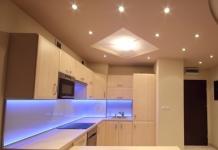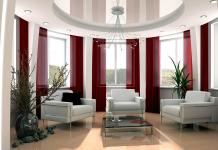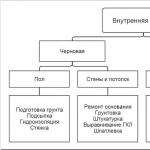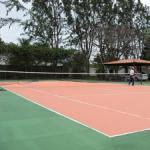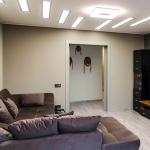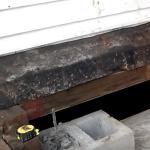Fine finishing is carried out at the last stage of repair work. It includes a number of procedures that make it possible to obtain a finished room. It is important to bear in mind that this process is started only after the completion of the draft work. If everything is done correctly, then the finishing procedures will not require much effort.
First of all, you need to decide what a fine finish of an apartment is. This concept does not have a clear, fixed designation, so there are several interpretations. In general, finishing works involve processes that do not require large-scale and labor-intensive manipulations, the result of which is a room that is absolutely ready for living.
On a note! The confusion arises due to the fact that there are several options for dividing repair work into stages. So, in the first case, the list includes only two processes: fine and rough finishing. But often there is an intermediate stage - pre-finishing. That is why the line between the works that should be included in each of the categories is a little blurry.
 There is no clear line of demarcation between the concepts of rough and fine finishing, they are defined only with general directions
There is no clear line of demarcation between the concepts of rough and fine finishing, they are defined only with general directions It should be borne in mind that currently it is possible to buy housing at various stages of the work. Many people prefer fully finished houses or apartments, which has a number of undeniable advantages:
- Check-in can be done immediately. All communications function, and the surfaces have a decorative cladding.
- There is no need for additional expenses, which saves the family budget a little.
- It is likely that the finishing work is done by professionals and is of good quality.
 Buying an apartment with a full finish has many advantages only if there is confidence in the decency of the craftsmen and the quality of the materials
Buying an apartment with a full finish has many advantages only if there is confidence in the decency of the craftsmen and the quality of the materials Of course, this solution also has disadvantages:
- If a new home is purchased with completed finishing work, then surely their cost is included in the final price of a house or apartment.
- Finishing is carried out in a standard way, without taking into account individual preferences.
- There is no way to check whether the rules and regulations have been followed. It often happens that the decorative cladding of walls, floors and ceilings is carried out when the surfaces are not yet dry enough after pouring the screed and plastering. This leads not only to damage to the coating, but also to the appearance of mold and fungus, which is very difficult to get rid of.
Thus, there are several options: to purchase turnkey housing, to independently carry out all or part of the activities, as well as to attract craftsmen whose work can be controlled.
 The golden mean is the purchase of housing for fine finishing
The golden mean is the purchase of housing for fine finishing General list of works and sequence of their implementation
The first stage - the final alignment of the walls and ceiling
The final leveling of the surfaces is carried out using a putty mortar. The fact is that plastering the base does not give evenness, which is necessary for laying many facing materials. So, if you do not get a perfectly smooth coating, then it is impossible to perform high-quality staining.
The process is as follows:
- The most suitable putty mixture for work is selected.
- If the product is purchased in dry form, then it is preliminarily diluted with water and kneaded.
- Plastered surfaces are primed.
- Application is carried out with a spatula and a rule. A trowel is used for final leveling.
 The general procedure for finishing plastering is simple, but requires certain skills
The general procedure for finishing plastering is simple, but requires certain skills This activity is more suitable for pre-training, so it may fall into more than one category.
Second - laying tiles
Tiles are considered an ideal material for cladding areas such as kitchens, bathrooms, toilets and corridors. Of course, if necessary, this solution can be abandoned, but such products are suitable for objects with high humidity or pollution.
It is important to consider that this process is started after the walls have been processed, but before the installation of plumbing and interior items. The humidity of the facing surface must be assessed; a specially selected adhesive composition is used for fixing.
 Laying tiles is carried out after arranging the piping, but before installing plumbing fixtures
Laying tiles is carried out after arranging the piping, but before installing plumbing fixtures
Details are stacked according to the existing scheme, uniform seams are formed between the elements. After installing the entire coating, you need to wait until it dries completely. Next is the cleaning and grouting of the seams.
Now there is a wide variety of material, it is divided not only by decorative qualities, but also by the surface on which it will be mounted.
Third - work with the ceiling
For finishing cladding, different options can be used. The most popular at the moment is considered to be a stretch ceiling, and the most inexpensive is painting or pasting with cheap foam or polystyrene boards.
 Under the stretch ceiling, the surface does not need to be prepared, all other options require leveling the surface
Under the stretch ceiling, the surface does not need to be prepared, all other options require leveling the surface Fourth - flooring
The floor experiences the greatest loads, so it is necessary to carefully consider the process of its lining. Draft work most often assumes that such a surface will be filled with a screed, but it does not always allow you to get a really even coating. Therefore, before finishing, a final leveling is performed using a self-levelling compound.
In the future, when the floor is completely dry, various materials can be used for work. If part of the premises is tiled, then for the rest, the most popular is the use of carpet, linoleum or laminate.
 In the public sector, there is now a fairly large selection of finishing materials.
In the public sector, there is now a fairly large selection of finishing materials. Fifth - final wall cladding
Fine wall decoration can be carried out using complex or simple options. The following solutions stand out:
- Wallpaper. There are many varieties of material that differ in their characteristics. So, paper products are considered the simplest. To obtain a better result, it is recommended to use non-woven and vinyl options. Wallpapering is not the most difficult process that requires accuracy.
- Coloring. This method has long been considered one of the most popular, at the moment it is used much less often, because to get a really beautiful surface you need to try. Painting involves the perfect preparation of the walls. For work, suitable compositions are used, which are applied to the base in a convenient way. The main thing is to get an even coverage.
 The middle option between wallpaper and painting are wallpaper for painting.
The middle option between wallpaper and painting are wallpaper for painting. - Use of decorative plaster. This group also includes compounds that are able to create a textured and textural effect. But to get the necessary surface, you need to have some skills.
- Installation of panels, lining or decorative stone. Each option makes it possible to get an original interior and has its own characteristics.
 Venetian plaster and facing stone are among the elite types of finishes, but if desired, they can be equipped with your own hands.
Venetian plaster and facing stone are among the elite types of finishes, but if desired, they can be equipped with your own hands. Indeed, do-it-yourself wall decoration involves many solutions, which allows you to choose the most preferable.
Sixth - electrical
During rough work, electrical cables are laid and power consumption points are created. And when finishing, external electrical equipment and components are installed: sockets and switches are mounted, lamps and sconces are hung, the correct connection in junction boxes and the presence of all external devices in the shield are checked. All work is carried out after facing the surfaces.
 Sockets and switches are mounted only after finishing the walls
Sockets and switches are mounted only after finishing the walls On a note! If frame structures are arranged on walls and ceilings, then it is necessary to provide for the distribution of wiring.
Seventh - plumbing
Plumbing is mounted at the last stage, in order to exclude its damage, it is necessary to plan in advance the creation of wiring. Due to the fact that polypropylene pipes are predominantly used today, they can be laid over the finish with care. Plumbing is installed in accordance with existing rules, all connection points are carefully checked. Then it remains only to arrange and hang interior items.
Thus, finishing activities complete all work, creating premises that are fully habitable.
There are several successive stages in construction, and finishing work is one of them, because in the construction of a building, the construction of a box is essential, but not final.
For example, the most that is not a simple redecoration of an apartment usually consists only of finishing work. While the capital, which includes several stages, finishing work is completed.
Meaning
Finishing work is the most important stage in construction and in any repair, since the appearance of the room, its atmosphere, and, as a result, the mood of the people in it, depend on the quality of this type of work.
From the right palette of colors, their combination, the quality of materials and the very performance of work, the impression that those present in the room receive, their feelings, as well as convenience, comfort and time savings depend.
Internal finishing works in overhaul
Over time, all buildings and structures need major repairs, this is an action that requires a serious approach, high-quality materials and the latest equipment, since this type of repair, in terms of its significance and the amount of work performed, is more like a reconstruction of a building.
Finishing work is the final stage in a major overhaul, which is usually preceded by activities such as:
- reinforcement of the foundation and load-bearing structures (walls and beams);
- a set of actions related to waterproofing and designed to protect the room from moisture.
Alternatively, the cost of finishing the premises is included in the price of the overhaul. But at the request of the customer, the estimate for finishing work can be made into a separate document in order to detail material and financial costs.
Finishing work. Kinds
These works are carried out in a certain sequence, depending on the wishes of the customer or the property owner and on the specific tasks assigned to the performers.

Finishing work is a set of actions that can be conditionally divided into several groups:
- floor finishing;
- ceiling finish;
- wall decoration.
All component stages of finishing activities can have a wide price and quality range. You can always invite an interior designer to design a room in a specific style or to acquire maximum practicality, style and aesthetics. But this should be done before the repairmen begin their work. After all, the cost and duration of the execution of ideas depends on the type of finish and materials for its implementation.
wall decoration
Usually, this is where interior finishing work begins, which consists of the following stages:
- preparation of walls - includes actions for leveling or giving them the necessary shape, for this they use plaster, gypsum or drywall;
- next comes the stage of puttying or finishing leveling the walls;
- then decoration is carried out (for example, painting the walls or pasting them with wallpaper).
Wall preparation is of the utmost importance in wall decoration, as a smooth wall surface is a very rare occurrence in most homes. And how the coating will lay down on the walls depends on this action, and the general appearance of the room also largely depends on the relief.
At this time, the most common type is wallpaper, staining occurs on their heels.
But there are lovers of interesting solutions that are ready in their homes with various panels.
It happens that the interior decoration of the walls includes the installation of decorative panels, which include plastic, MDF or fiberboard. For this type of work, the task of the masters is greatly simplified, because the procedure does not require alignment.
Ceiling finish
The situation with the surface of the ceilings is a little better than with the walls, sometimes there may be irregularities at the joints of panels or beams, but all this is well corrected by professional tools combined with skills. But if there is trouble with the relief of the ceiling, then special types of coatings come to the rescue, which can easily mask all the shortcomings of the builders.

But first things first.
The internal finishing work of the ceiling depends on the coating chosen by the customer for it, as well as the way in which they will be carried out.
At this time, there are several types of ceilings:
- tension;
- painted;
- hinged;
- pasted over.
The most popular one, and one that the decorator usually recommends, is a painted ceiling. It does not require special physical effort, material costs and time. The only thing that precedes the painting of the ceiling, and even then not always, is the preliminary leveling of its surface.
In second place in popularity are pasted over ceilings. It can be panels of various materials or any kind of wallpaper. This type of ceiling is inexpensive, simple and aesthetic.
The estimate for the finishing work of a stretch or suspended ceiling can unpleasantly surprise with its considerable result, but if the owner of the premises does not have a question about saving material resources, then this option is very good.
There is a wide variety of color options to which you can add some creativity and originality (different levels, relief, combination of shades and textures).
Floor finish
It includes a number of works on leveling the floor and installing a concrete screed, the final stage here is the installation of a floor covering, which the owner of the premises must choose. It can be laminate, parquet, linoleum, tiles or boards.

As for the laying of ceramic tiles and tiles, then you will need a master of finishing works, specializing in this. Since laying tiles is a job that requires a certain amount of experience and skills. In this way, you can decorate not only the floor, but also the walls in the bathroom, shower, or lay out a work apron in the kitchen. Sometimes the laying of tiles is included in a special category and in a separate price list for repair and finishing work.

Who to trust?
If the prices for finishing work scare you, or if you have some knowledge and skills in decorating the premises, then you can do it on your own. But there is no execution, covering additional costs or paying penalties and solving problems that have arisen at the stage of finishing work.
But in most cases, property owners resort to the help of professionals, among whom it is possible to find those who offer affordable prices for finishing work, their quality performance and guarantee.

Advantages of repair and finishing companies
Most organizations that specialize in repair, construction and finishing work provide:
- detailed development of the plan and budget;
- individual approach to each order;
- modern equipment and advanced technologies;
- highly skilled workers;
- finishing in rooms of any degree of complexity;
- performance of work within the specified time;
- a guarantee for the performed types of work, which is provided after their completion.

Calculation of the cost of repair and finishing works
As for the prices for finishing works, they differ significantly in different regions of the country. For example, in Moscow, the Moscow region, St. Petersburg and the Leningrad region, the cost is much higher than in Saratov, Tomsk or Cherepovets.
Also, the price of finishing largely depends on the materials, the complexity of the work and the timing of their execution. But in all cases, there is one principle: the larger the area of the premises, the higher the price for the services rendered.
In most companies, the operation to calculate the cost of finishing can be done online; for this, there is a special calculator on the organization’s website, with which you can easily find out how much the planned event will cost.
There is another way - very often on those very sites of repair and construction companies there is an opportunity to use the services of an online consultant for free, who will help make preliminary calculations and orient on other basic issues.
Interior design is an issue that should be taken care of while building a house or even at the inception stage of its project. Interior design can be done independently, having decided on the layout of future premises and the arrangement of furniture, or entrust this work to a professional designer. According to the desired interior decoration of the house, we will draw up a plan for you to unfold the walls and ceilings of each of the rooms, agreeing on such important trifles as the location of all sockets, switches and lighting devices. Together with you, we will discuss and solve all the technical issues of the upcoming interior decoration of the rooms.
| 2. The next step is the installation of all internal walls and partitions. Brick or aerated concrete can be used as a material for the walls of the first floor, and walls and partitions on the second and subsequent floors, in the case of floors on wooden beams, are usually constructed from double plasterboard sheets (GKL). At the same time, it is very important to control the height and width of the doorways, so that when installing door frames and doors, the platband must cover part of the wallpaper or decorative plaster. This and many other nuances, of course, are known to experienced builders and are taken into account at the very beginning of interior decoration. In parallel with the installation of walls, it is possible to carry out the insulation of floors between floors and the installation of floors (logs, plywood or OSB boards). | |
 |
3. At the third stage of finishing work, a rough floor screed is made. To do this, the main engineering communications are installed: an electric cable is pulled into the house, pipes for water supply and sewage pipes are drawn, and diesel fuel is supplied if there is no gas pipeline in the house. The source of water supply can be central water supply systems, wells or wells. When all the necessary communications are connected, the floor is covered with expanded clay (or half sand and then expanded clay), on top of which a rough concrete screed is poured. |
4. Next, lay and install all engineering communications. At this stage of the finishing work, the walls are ditched, the electrical cable is pulled, and the sockets for sockets and switches are prepared. On top of the rough screed, a special heat-retaining material isolon is spread, covered with a special mesh and underfloor heating pipes are laid. Lighthouses are set up and the floor is filled with plytonite or vetonite. Pipes are stretched to all heating radiators and pipes with a heating cable are brought into the house from a water supply source. They carry out gating and wiring of pipes for hot and cold water supply, lay pipes for internal sewerage and draw a conclusion to the septic tank. At the same time, it is necessary to know in advance the plan of the kitchen and bathrooms, with all the furniture and plumbing fixtures.


6. Then the walls are prepared for wallpapering or applying decorative plaster (Venetian, etc.). It is important to strictly adhere to the established technology of finishing works: priming the walls, installing a galvanized mesh, plastering on lighthouses, puttying. At the same time, the finishing of window slopes, ennoblement and installation of plastic or stone window sills are carried out.
7. The seventh step is the installation of ceilings. If reinforced concrete floors are installed in the house, then plastering is carried out on the lighthouses. Otherwise, the ceiling is usually sheathed with plasterboard (gypsum plasterboard), and in the attic or in the bathroom on the second floor, you can make a ceiling from a lining.
9. The penultimate step is the finishing of the premises. The walls are pasted over with wallpaper, tiled, sheathed with clapboard or painted, an apron is arranged in the kitchen; tiles, parquet or laminate are laid on the floor; doors are being installed, skirting boards and thresholds are being installed. Light fixtures, sockets and switches are installed and connected. Plumbing is installed: bath, shower, sink, toilet, bidet, mirrors and other accessories. After pasting the walls with wallpaper, heating radiators are mounted, and the rooms take on a finished look. Furniture is delivered and installed.



10. At the final stage, the boiler room is connected, the boiler is installed and the heating and water supply systems are launched. If it is planned to install a diesel burner, then outside the house (as an option: dug into the ground) a container for diesel fuel is built, insulated and covered with a canopy. A water purification system is mounted using conventional cartridges in flasks, such as Big Blue. But if the water contains hazardous impurities or heavy metals, then our trusted partners install a more complex water purification system, on the principles and features of which we are ready to give additional advice.


All the listed works on each of the ten points are carried out responsibly and efficiently by the specialists of the ABC of Construction.
Finishing is an important stage of work in the process of construction and repair work. At this moment, the features of the interior of the apartment acquire their final shape. The sequence of actions during finishing is not affected by any conditions. Such work is performed in a certain sequence. The stages of completing the construction and finishing of the house should be considered in more detail.
Final stage of construction
At one of the last stages of building a house, you need to install windows. They are mounted when the walls and roof are ready. Only after installing the windows can you start finishing. In addition, it is necessary to make a screed and putty.
Finishing the house begins with the implementation of the screed in each room. A few days after the pouring of the concrete solution, you can move freely on the floor surface. Complete drying of the screed is possible only 6 weeks after pouring the concrete. This is necessary so that it gains optimal strength before finishing.

Once the screed is completed, you can start plastering the walls and ceilings. This layer of finish will also take time to dry. Then puttying is performed and tiles are laid.
Preparation for interior decoration
How good the interior finish will look depends on how well the base for the finish is prepared. The surfaces of the ceiling, floor and walls that will be finished must be carefully leveled. For this, special solutions are used. If a normal humidity indicator is determined in a room, the preparation of walls for finishing in it is carried out with gypsum.

Important! Wall surfaces in the bathroom and other rooms with high humidity must be prepared for finishing using cement mixtures.
There should be no cracks on the finished surface. It should be even and smooth. If further wall finishing is required, the surface must be additionally leveled with putty. The cement screed on the floors is covered with a self-leveling leveling compound.

When the screed and plaster dry, they are covered with a primer. Such solutions are able to reliably strengthen the base, as well as close the pores in the material before finishing. Such processing can increase the adhesion of the finishing material. In addition, the use of such solutions allows you to save a lot on the purchase of paint for finishing.
Screed drying temperature
At the stage when the floors will dry out, a certain temperature must be maintained in the room. It is important to pay attention to the creation of high-quality ventilation. If the plaster dries in sub-zero temperatures, the strength of this layer may decrease, which will affect the condition of the finish later. If the temperature is too high, drying will be accelerated. As a result, the plaster may crack. It is better that the temperature in the room is maintained in the range of 10-20 degrees.

When plastering walls in winter, maintaining a certain temperature indicator is quite simple. Radiators are used for this purpose. Drying using diesel appliances or electric heaters requires a lot of attention and control.
During drying, the room should be well ventilated. This work needs to be done regularly. Thanks to this, moisture will be successfully removed to the street.

Door installation
If you plan to install doors, this must be done after the plaster layer has completely dried. Depending on the speed of drying, you will need to wait about a week or two.
This condition must be met so that the moisture that comes from the walls is not absorbed by the wood. If this happens, the boards will swell and become unattractive. Only when the plaster is completely dry, you can install interior doors.
When the doors are installed, it is necessary to check how correctly the installation was carried out. If everything is done in accordance with the technology, the doors can be removed. This will increase the convenience of laying floors.

Installation of window sills is carried out in the same period. Installation of wooden structures is carried out only when the layer of plaster is completely dry. This avoids swelling of the window sill as a result of moisture absorption from the plaster layer.
Laminate flooring
When the screed and plaster are ready, you can proceed with the installation of the floor. If you want to make a wooden flooring, you need to find out what kind of humidity the screed has. For this, an electronic hygrometer is used. Wood is a rather demanding material when it comes to water. Wood perfectly absorbs moisture, which leads to deformation of the boards after finishing the floor.

To adapt the material to the conditions of a particular room, it must be placed in a room for 2-3 weeks. This will ensure that the moisture content of the wood and the environment in which it is located are equalized. This has a positive effect on the final result. This procedure allows you to increase the time it takes to complete the work.
Walls and floors must be completely dry before laying laminate flooring. Only if the laying of the boards is done correctly, the coating acquires an attractive appearance and excellent practical characteristics. Finishing the floor is a rather painstaking process, so it is important to take into account all the nuances.

Wall and ceiling painting
The next step is to paint the walls and ceiling. Before such work, the door frames are protected with an adhesive film, which is attached to the adhesive tape. The first time the paint is applied to the walls, the floor is applied when the floor has not yet been laid. The second layer of the coloring composition is applied after polishing the floor surface. This procedure is necessary, because during the installation of parquet boards a lot of dust rises into the air, which can spoil the appearance of the painted surface.
Laying ceramic tiles and tiles
Laying ceramic tiles is associated with fewer problems than installing parquet. Due to the many positive properties of the tile, its installation on the screed can be carried out even after 2 weeks from the creation of the base.

The same period is necessary for tiles on plastered walls. In the presence of wooden panels, it is necessary to allocate a week more for drying the plaster. If the panels are placed on a floor that is too damp, they may swell, leading to mold.
Re-staining
The second time the coloring composition is applied only after the laying of the floor, as well as the installation of the doors, are completed. If it is decided to paste over the walls with wallpaper, at this stage it is necessary to start gluing them. Before painting the room should be well vacuumed. This will prevent dust from settling on the finishing material.

Important! Sockets and switches are installed after applying three coats of paint.
Kitchen finishing
When decorating the kitchen, you need to remember a few nuances that should be taken into account to make the work easier:
- Furniture can be assembled after the first painting of the walls. This will avoid abrasions and the appearance of dirty spots on the surface after finishing.
- If the wall will be finished with tiles, its installation should be carried out even before the installation of the countertop. Between the intended level of the countertop and the lower edge of the tile, it is necessary to leave a gap of 1 cm. When the countertop is fixed, it will be covered with a plinth.
- Do not rush while finishing. Floor and wall surfaces must be thoroughly dried after a layer of plaster and screed has been applied. If this condition is not met, other trim layers will not be possible to perform. Drywall will begin to bend. Each parquet board will begin to walk. Such effects often appear when finishing work starts too early. This mistake is the most common among inexperienced builders.

Given these tips, you can finish the apartment at a high level. You can handle this job on your own.
Home finishing
At the last stage of finishing the facade of the house, decorative material is applied. Facade paint is applied using a spray gun or roller. In the first case, the layer of the coloring composition is more uniform.
At the stage of creating a plaster layer, it is important to completely finish the wall within one working day. If there are unfinished sections, the junctions of the old and new plaster will stand out.

Such a problem is solved quite quickly if there is an optimal number of workers who will cope with the work in the shortest possible time. In addition, the facade can be divided into separate parts, which can be separated from each other by rustication or cornices.
When installing tiles on the walls of the house from the outside, only special adhesives should be used. If at this stage the wall is finished with a traditional concrete solution, a metal mesh should be used.
empstenup/ February 24, 2016 / /
There are several finishing options. The first type is draft, which includes the installation of the front door and double-glazed windows. The second type is the final finishing of the apartment, which includes floor screed, electrical connection, wall and ceiling alignment.
Stages and sequence
It can be conditionally divided into several stages:
- preparation: disassembly of partitions, plastering, cleaning and cleaning;
- rough finish: applying plaster, installing drywall, puttying;
Fine finishing of the apartment is also called finishing. After its completion, residents can safely enter the house. When building a residential building, rough work is indispensable. But when it comes to acquiring a new apartment, developers usually do only rough work. Apartments with a fine finish are more expensive and are not in great demand. Therefore, most often the owners themselves do the finishing.

Advantages
- Budget type of finish.
- After the work is done, you can immediately move into the room. All switches, plumbing and doors will already be installed.
- Such repairs will suit unpretentious people in everyday life for several years.
Flaws
- It is easier to redo a room from scratch than to carry out a final design.
- It is not possible to make adjustments during the finishing process.
- Hidden flaws left after construction will be more difficult to finish.

Jobs (what exactly do we do?)
Let us consider in more detail the stages of the work.
- Laying tiles. This is the final type of tiled work. As well as grout.

- Installation of PVC panels. After installation of plastic panels, it is not necessary to cover the surface with paints or varnish.

- Putty refers to both types of room design. If we are talking about, then this is rough work. And if the design of the room provides for decorative puttying of one of the walls, then this is the final stage of the repair.

- Wallpapering, of course, refers to the finishing stage.

- Installation of rack, stretch ceilings is the final step. Although painting is carried out in several stages, after its completion, other activities will not be carried out.

- When installing floors finishing works include: laying laminate flooring, linoleum flooring, laying flooring from boards, ceramic tiles, installing skirting boards.

- Electrical equipment. Switches and sockets are mounted after the completion of the wall decoration. The same applies to the final assembly of the sconce, installation.
 Plumbing, dryers and mixers are installed after finishing the walls. At large-scale facilities, heating devices are mounted after construction, but then they have to be removed.
Plumbing, dryers and mixers are installed after finishing the walls. At large-scale facilities, heating devices are mounted after construction, but then they have to be removed.

- Platbands and interior doors installed last.

First you need to decide on the design of the room, think about what materials will be used, choose colors, design the connection of electrical appliances. Not only the aesthetic appearance of the room depends on the quality of the preparation, but also the wear resistance and durability of the repair.
Work order
It is desirable to carry out the finishing "from top to bottom":
- At the first stage, the dirtiest work is carried out: laying tiles in the bathroom, corridor and kitchen, completing electrical and plumbing work.
- Ceiling installation: panel installation, painting.
- Wall decoration: wallpapering, decorative plastering, painting.
- Installation of flooring: laying parquet, tiles, laminate, carpeting, linoleum.
- Installation of interior doors, household appliances.

Financial Benefits
As you can see, the creation of a fine finish requires large material costs. But if we are talking about buying an apartment in the primary market for the purpose of renting it out, then it is better to immediately purchase a fully furnished room.

Work from the developer is cheaper than repairs on their own. The company buys materials in bulk at a lower price. Accordingly, the cost of work is reduced. But the quality of the repair can be different. Apartments with municipal renovation can suit residents for the first few months. If such premises are rented out, the market price will decrease by 10-15%.
2 videos about finishing
28 Photos of finishing

















 Laying ceramic floor tiles - man hands marking tile to be cut, closeup
Laying ceramic floor tiles - man hands marking tile to be cut, closeup 


